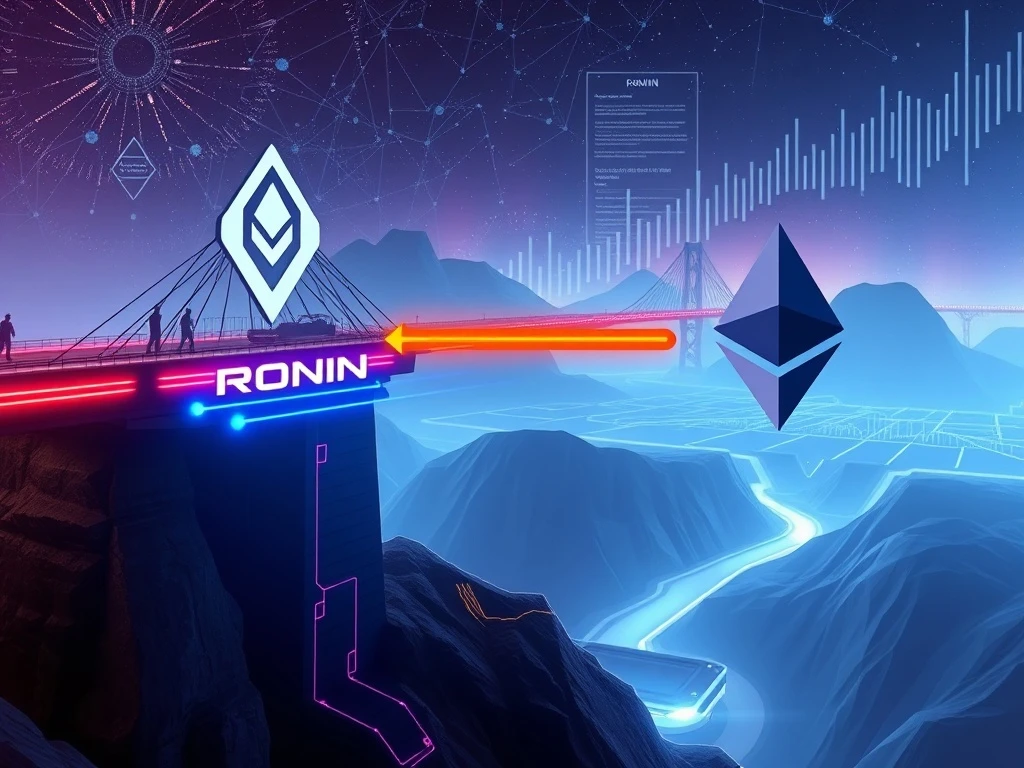Ronin Network’s Strategic Return: A Transformative Leap to Ethereum Layer 2

A monumental shift is underway in the blockchain gaming world. The **Ronin Network**, famed for powering the popular game **Axie Infinity**, is making a significant move. It will return to the Ethereum ecosystem as a Layer 2 (L2) network. This decision marks a pivotal moment. It transforms Ronin from a specialized gaming chain into a versatile, general-purpose blockchain. This evolution is set to impact the broader Web3 landscape, especially for developers and players alike. Moreover, it highlights Ethereum’s growing appeal to institutional capital.
The Journey Back: Ronin Network Embraces Ethereum Layer 2
The **Ronin Network** originally spun off from the Ethereum mainnet in 2021. This departure sought better performance. It aimed for faster network speeds and cheaper transaction fees. These improvements were crucial for the burgeoning **Axie Infinity** game. However, the blockchain landscape has evolved rapidly since then. Ethereum has undergone significant upgrades. Transaction costs are now dramatically lower. Network speeds have also improved considerably. The Ronin team recognized this shift. They stated, “Things are different now. Ethereum is back. Transaction costs and speeds are better than ever.”
This return signifies a renewed confidence in Ethereum’s scalability solutions. The full migration from a standalone Layer 1 blockchain to an **Ethereum Layer 2** network is ambitious. Ronin has set a target of Q2 2026 for its completion. This phased approach ensures a smooth transition. It minimizes disruption for existing users and developers. The move promises to combine Ronin’s gaming expertise with Ethereum’s robust security and vast ecosystem.
Why Ethereum’s Wall Street Appeal Drives Ronin’s Decision
A key factor in Ronin’s decision is Ethereum’s increasing allure for traditional finance. Ronin explicitly cited, “Ethereum is winning the war for Wall Street’s attention and capital.” This growing connection between institutional investors and Ethereum is undeniable. Several initiatives underscore this trend. For example, Etherealize launched in January. This marketing company actively pitches Ethereum to Wall Street investors. It receives backing and funding directly from the Ethereum Foundation. This highlights a concerted effort to bridge the gap between crypto and traditional finance.
Furthermore, the emergence of Ethereum treasury companies signals a new era. These publicly traded businesses accumulate Ether (ETH) on their balance sheets. This strategy provides a cohesive narrative for Ethereum. Matt Hougan, Chief Investment Officer at Bitwise, explained this appeal. He noted that putting ETH into an “equity wrapper” is familiar to investors. This wrapper can accrue yield through staking. It offers a comfortable investment vehicle for traditional financial players. This growing **ETH Institutional Investment** makes Ethereum a compelling platform for established projects like Ronin.
Axie Infinity and the Future of Gaming Blockchain Development
The implications for **Axie Infinity** are substantial. As Ronin becomes an **Ethereum Layer 2**, Axie Infinity will benefit directly. It gains enhanced security from Ethereum’s mainnet. It also taps into Ethereum’s deep liquidity. This shift will allow Axie Infinity to scale further. It can accommodate more users and transactions efficiently. This move is not just about one game, however. Ronin’s transformation into a general-purpose chain opens doors for the entire **gaming blockchain** sector. Developers can now build diverse applications on Ronin. These applications will leverage Ethereum’s infrastructure. This could spur innovation across Web3 gaming.
Proponents envision Ethereum as the backbone of a new financial system. It acts as a base layer for decentralized finance (DeFi). It also supports real-world asset tokenization. Moreover, it facilitates stablecoin settlement. The recent GENIUS bill in the US prohibits yield-bearing stablecoins. This legislative change could push investors towards Ethereum DeFi. Here, they can still earn passive income through staking or lending activities. This environment makes Ronin’s return even more strategic. It positions the network at the nexus of gaming, DeFi, and institutional capital.
Enhanced Opportunities with ETH Institutional Investment
The influx of **ETH Institutional Investment** strengthens the entire Ethereum ecosystem. This capital provides stability and resources. It supports further development and innovation. When major players like Ronin choose to integrate, it validates Ethereum’s long-term vision. This validation attracts more projects. It also draws more users. The “equity wrapper” concept described by Hougan simplifies investment. It makes ETH accessible to a broader audience. This institutional interest can drive up Ether’s price. It also enhances network security through increased staking. The growing institutional confidence in Ethereum’s capabilities signals a robust future. This future includes advanced **gaming blockchain** applications.
The synergy between Ronin’s specialized gaming focus and Ethereum’s general-purpose capabilities is powerful. It combines a proven gaming platform with a secure, liquid, and institutionally favored blockchain. This integration offers significant advantages. It includes greater developer tools and a wider user base. The migration represents a strategic alignment. It positions Ronin for sustained growth. It also reinforces Ethereum’s dominance as the preferred platform for innovative Web3 projects.
The Strategic Advantage of Ronin as an Ethereum Layer 2
Becoming an **Ethereum Layer 2** offers several strategic advantages for Ronin. Firstly, it significantly boosts security. Ronin will inherit the robust security guarantees of Ethereum’s mainnet. This is crucial for protecting user assets and game economies. Secondly, it enhances interoperability. Projects built on Ronin will seamlessly interact with other applications on Ethereum. This fosters a more connected and liquid ecosystem. Thirdly, it leverages Ethereum’s massive developer community. This access can accelerate innovation on Ronin. Developers can utilize familiar tools and existing infrastructure. This reduces development time and costs.
This strategic move also benefits the broader Web3 gaming landscape. It sets a precedent for other gaming-focused chains. They might consider similar integrations. This could lead to a more unified and efficient blockchain gaming environment. The decision by the **Ronin Network** to return to Ethereum is a testament to Ethereum’s evolving strength. It highlights its position as a leading platform for future decentralized applications. This includes the next generation of **Axie Infinity** and beyond.









